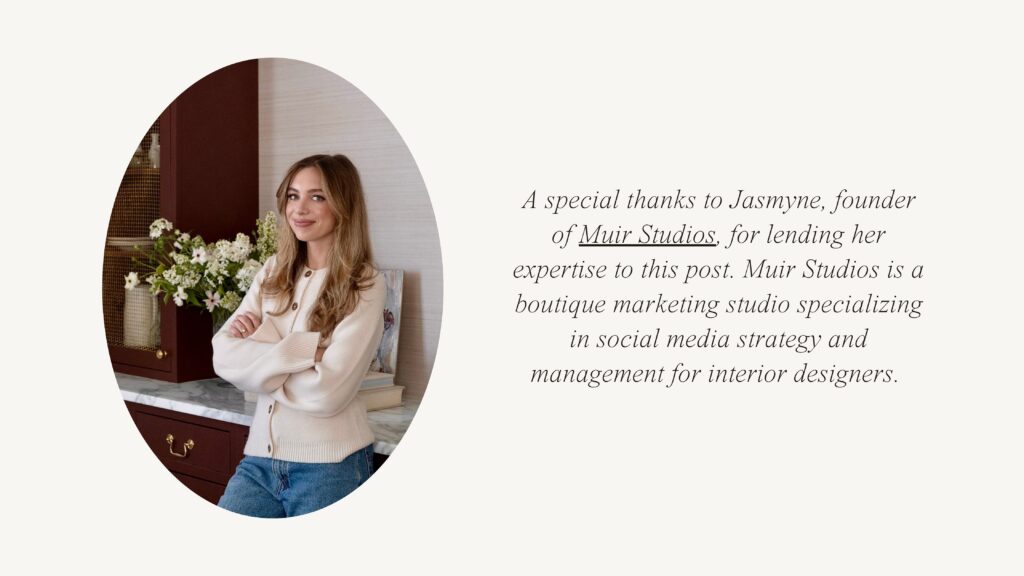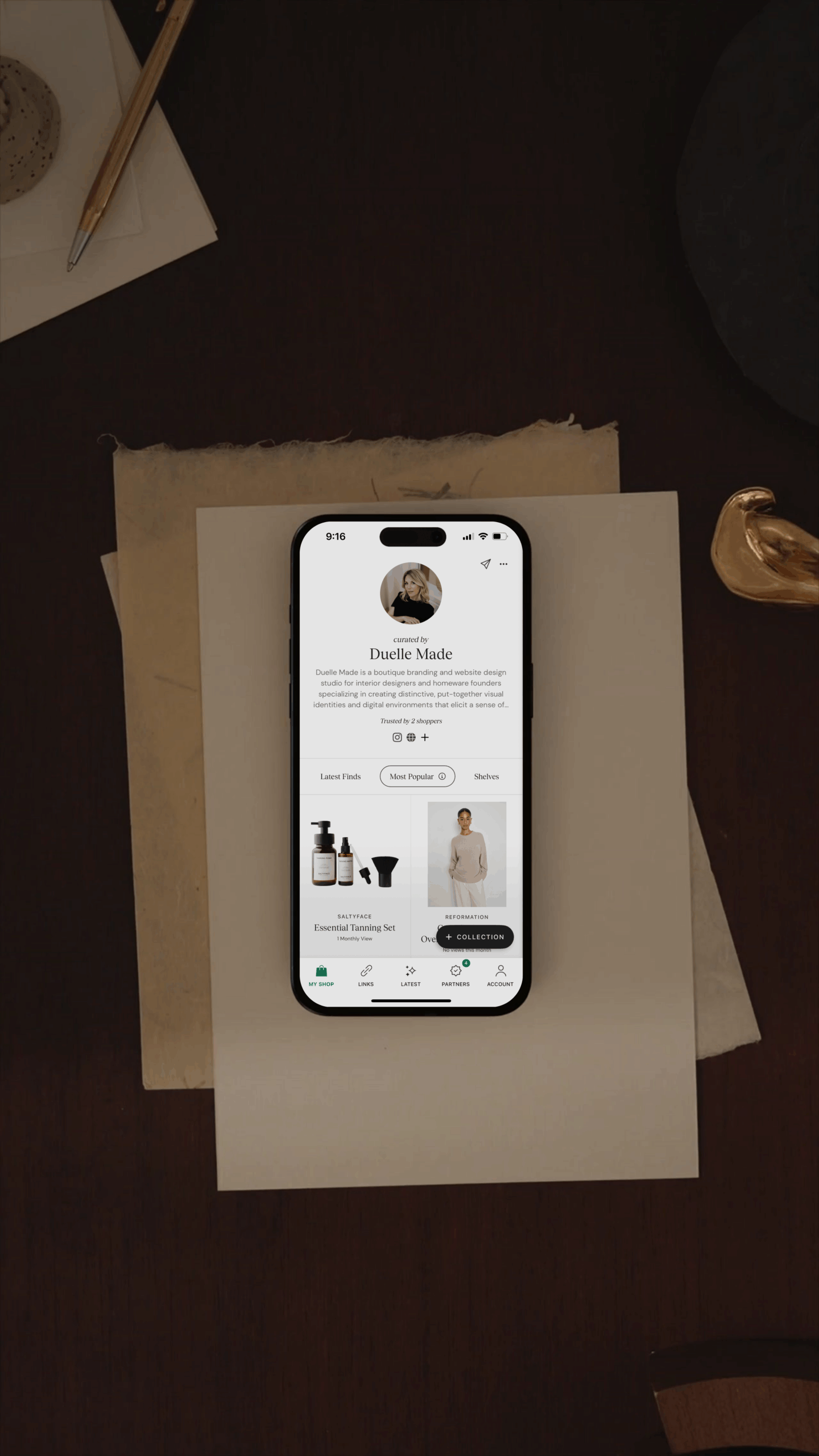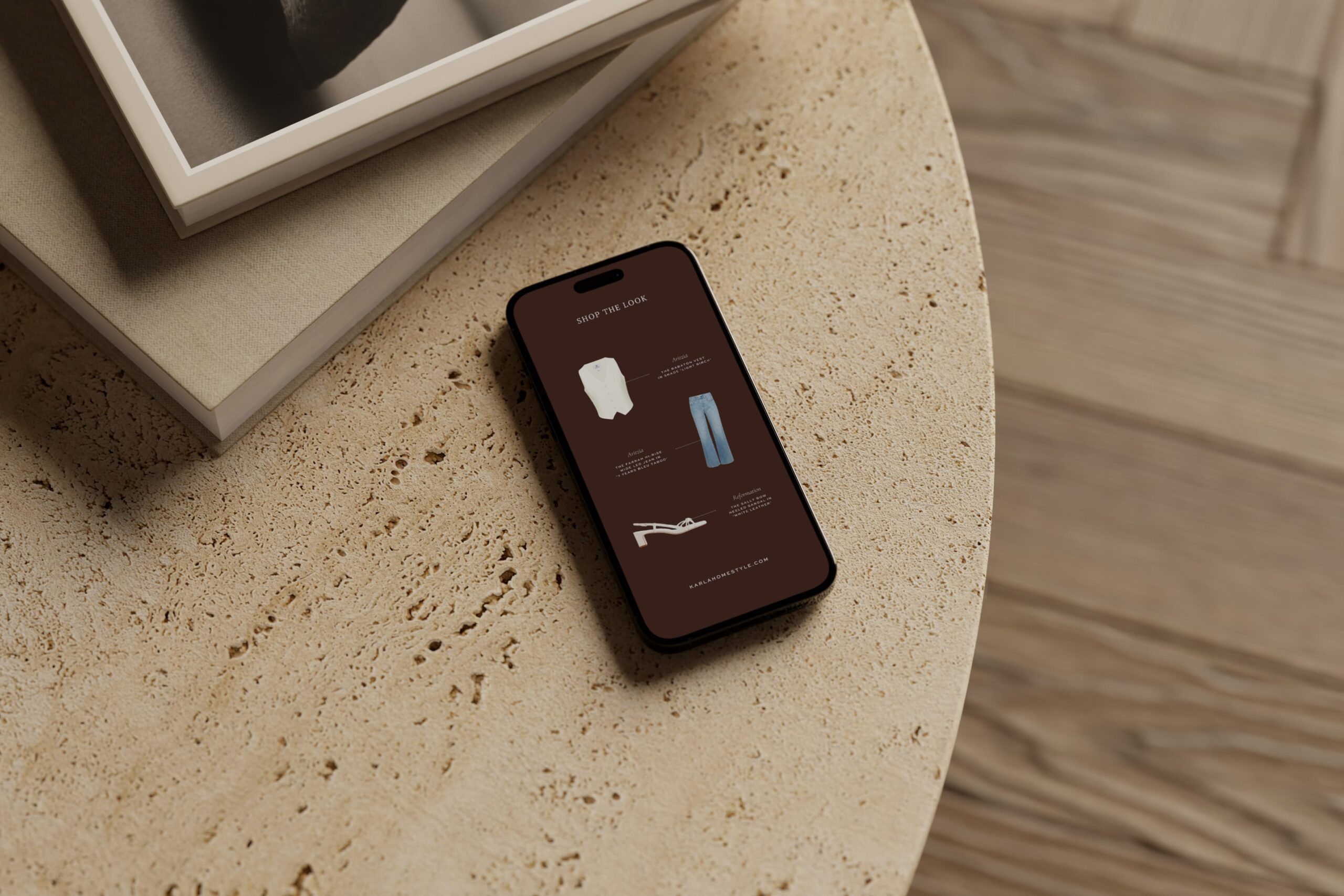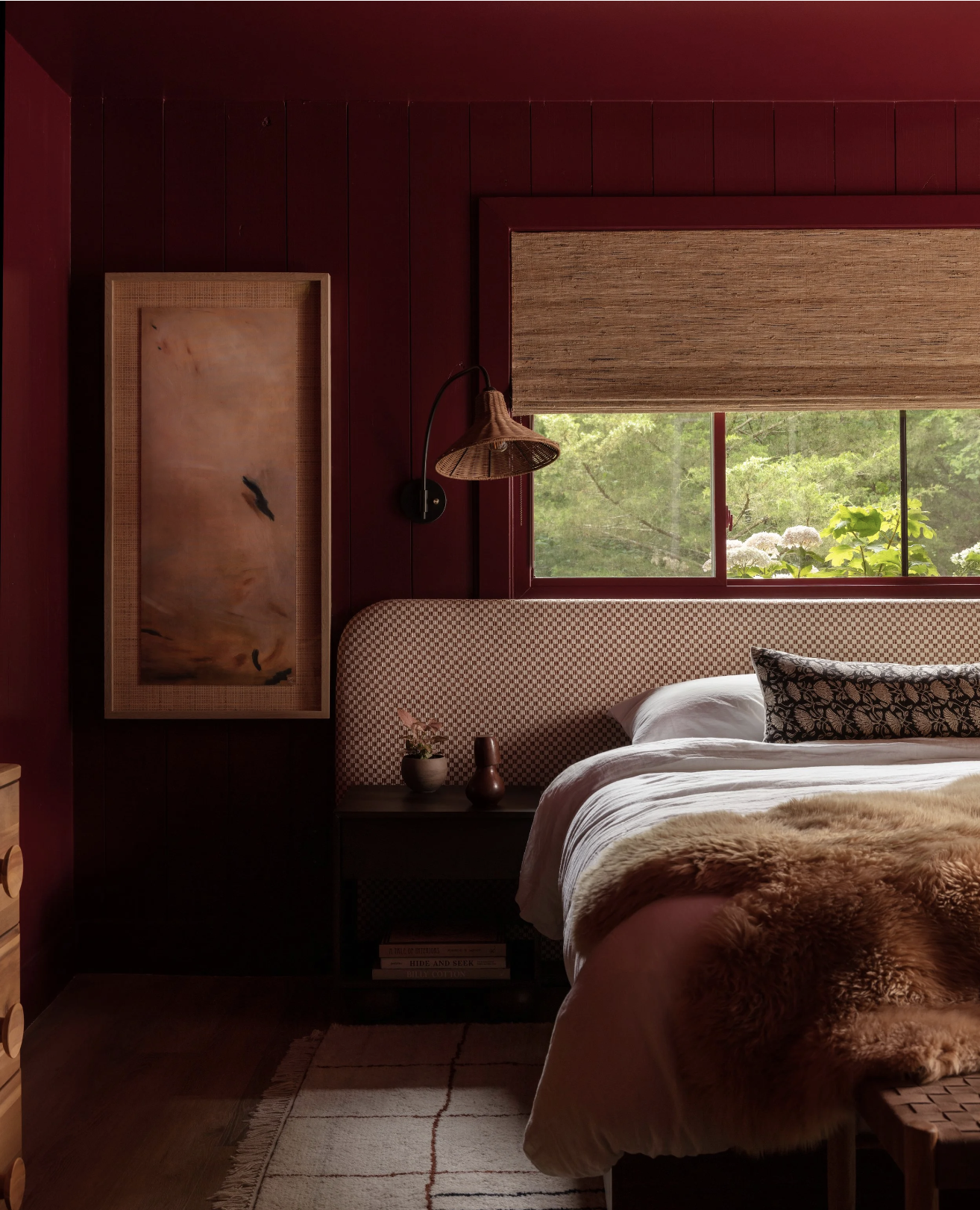Design appreciation has reached new heights in today’s visually heavy landscape. Now, it’s more important than ever to show up and share your unique vision and approach to connect with interior design clients who need and value your services.
But toggling between personal life, creative work, business development, the fast-moving pace of AI, ever-changing social platforms & features, and algorithms can be SO hard. Then there’s the vulnerability of putting yourself out there, when self-doubt whispers not-so-nice things like:
“Is my work good enough?”
“So and so does this much better than me.”
“Who am I to think I have something valuable to contribute?”
“What’s the point in even trying?”
This guide is your supportive framework, acknowledging genuine doubts and obstacles while offering straightforward marketing strategies to attract more aligned interior design projects.

Humanize Your Brand With Social Media
It’s easy to get caught up in keeping up with everyone else. So much that you start hesitating and overthinking what you’re about to post. But people want to hear from you and SEE you.
More than platforms, Instagram and Pinterest are invitations for others to enter your creative world. While it can be a lot to manage, it’s important. Just consider how Jake Arnold’s team at The Expert vets designers by first looking at their Instagram profiles.
Instagram Solutions
1. When you’re unsure what to post:
If you’re feeling overwhelmed, especially during a busy season, social media takes a backseat. Remove the pressure and focus on what feels good to you. Sharing glimpses into your world can be a simple, yet influential place to start. Whether it’s sources of inspiration within the city you call home, a site visit/progress update (the in-between moments of a project), or a seasonal mood board, authenticity resonates more than overthinking and trying TOO hard to create the “perfect” post.
2. When writing captions is feeling sticky:
There are many “formulas” out there for writing a good caption. But to invite conversations, your words should feel intentional and true to you. Get a little “untucked” with your writing in a way that leans into your personality.
Need a little boost from AI? Jasmyne shares, “AI tools can be great for helping generate ideas, but relying on them too much can make your social presence feel flat. If you utilize AI to write captions, be sure to tweak the voice and tone until it sounds like you.”
And as for something more specific to write about in your posts, Jasmyne suggests opening up about your process, how you solved a problem or addressed a specific need for a client, or what inspired the details behind your designs. This turns what’s often a single photo or carousel dump into something that can provide more insight to your ideal client.
3. When posting frequently feels overwhelming:
Consistency > frequency. If you don’t have the content or bandwidth to post every day, Jasmyne recommends spreading your content out so you don’t burn out. The algorithm rewards you for following through, meaning posting to your feed two or three times weekly is MUCH better than going hot and cold. You can show up in Stories more frequently than that to pull back the curtain on your behind the scenes and client feedback.
4. When you get anxious about curating a cohesive feed:
As someone who cares deeply about aesthetics, visualizing your feed before posting will only make you MORE likely to be consistent. Plann, Canva Pro, and UNUM are some of Jasmyne’s trusted feed visualization tools for creating a cohesive grid.
And when it comes to posting a Reel? Jasmyne offers this advice:
“One simple way to make your grid look more intentional and on brand is by editing your Instagram Reel cover images. You can upload any image or graphic from your camera roll to display as your cover or edit them later after posting.”
Instagram has also been testing options to rearrange the order in which your grid is displayed, giving you a little more control as a creator. We’ll see how that plays out! 👀
5. When creative bandwidth is limited:
Block an hour or so every week to map out your content for the following week – both in-feed posts/Reels and stories. Your days of creating content on a whim are limited when this planning session becomes a natural part of your routine. Plus, more structured time to conceptualize your social content ensures it’s aligned with business goals and that you’re not interfering with precious client work.
Jasmyne shares these thoughtful approaches for making the different layers of Instagram feel more effortless:
- Stories – There are perks to real, process-oriented, unedited stories. They perform better, help your audience connect with you in a more approachable way, and are less of a time lift.
- Reels – Reels can be a learning curve. But once you find some tools and templates that work for you (e.g., CapCut, Temply), they’re a lot more versatile for posting things like your BTS clips, project videos, and everything in-between. I’m a big fan of batching Reels (and any content, really!).
Pinterest Solutions
While yet another social platform to think about, Pinterest can increase visibility of your interior design work. Let’s look at some common hangups and how to address them.
1. When board names are too generic:
Jasmyne reminds us that Pinterest is a search engine, so what you name your boards matters. Instead of going with something like “Inspiration” or “Materials,” which get lost in the depths of content, be specific with your keywords. Try more descriptive names like “BATHROOMS: Natural Stone” to connect your carefully curated content with users searching for those exact areas of the home and/or design elements.

2. When finding a sustainable rhythm feels impossible:
While Pinterest rewards consistent activity, this doesn’t mean you need to rely on daily manual pinning. Jasmyne suggests using Pinterest’s built-in scheduler or Tailwind to plan your content calendar in advance. This approach transforms pinning from a daily chore into a manageable weekly (or monthly) session.
3. When the time investment concerns you:
It might look like just another to-do on your already-full calendar. But you’ll benefit from the platform’s longevity. Unlike other apps where content quickly disappears, your pins can direct traffic to your website for years after publishing. To get started, look to Pinterest Business for plenty of free tools and resources. Their complimentary trend forecasting can also inform your content strategy, helping you stay relevant without constant research.
And for an extra hand? Muir Studios offers strategy sessions to establish a more personal Pinterest strategy, along with specific ideas for cleaning up and optimizing your existing boards and pins.
Invite Ongoing Conversations With Blogging & Podcasting
While social media platforms come and go, blog posts and podcasts are a cornerstone of digital marketing strategy and search engine optimization (SEO) mainstay, especially for design professionals. They create value beyond beautiful images by addressing clients’ questions, concerns, and aspirations in depth.
Blogging & Podcasting Solutions
1. When determining what to post to your blog and how often:
Blogging may sound hard and time-consuming. But if you structure it more as a resource library to send to clients (instead of writing the same emails again and again), it starts to feel like a practical addition to your marketing efforts.
Aim for depth over frequency: one longform post (1,500-2,000 words) A MONTH will outperform weekly surface-level content. When planning your content calendar, consider:
- Client FAQs: What questions do you answer repeatedly in emails or consultations? Turn these into detailed guides.
- Process explanations: Clarify your design process with step-by-step breakdowns.
- Industry insights: Share your expert perspective on trends/patterns, materials, or sustainable practices.
2. When looking to optimize your blog posts for SEO:
After all, that’s one of the key reasons for writing blog posts! So you don’t want to miss out on this. If you’re using Showit for your website, you’ll use WordPress for your blog. WordPress makes it fairly effortless to stay on top of your SEO work for every blog post.
Without getting too in the weeds on this important topic, read our Expert SEO Strategies for Interiors Designers.
3. When securing podcast invitations:
It might seem obvious, but listening comes FIRST. Press play on shows like “The Interior Collective,” “Business of Home Podcast,” “A Well-Designed Business,” “The Chromologist,” and “Clever.” Get a better picture of their format, audience, and the type of guests they feature. Then:
- Engage with hosts on social media by commenting on their episodes.
- Develop a creative, clear pitch highlighting your expertise and specific value you can provide to their audience.
- Consider starting with smaller podcasts to build your guest experience before approaching the major players.
Nurture Online Relationships With Email Marketing
Want to grow a digital close-knit community for your brand? And know you’re in control of it? Email marketing is great for this.
The most effective email marketing feels personal rather than promotional. Use it as a space to share deeper stories, insights, offers, and value that recipients wouldn’t find on your public channels (like social media). Remember that each subscriber represents someone who has invited you into their inbox — a real privilege. Treat them that way!
Email Marketing Solutions
1. When you love the idea but have zero clue where to begin:
You’ll love Flodesk. It’s designed with aesthetically-minded business owners’ best interests at heart, offering intuitive templates and features that make it accessible – even if you’ve never sent a newsletter before. Start by creating these essentials:
- An email signup form. Place it strategically on your website – not buried in your footer. But prominently on your home page, blog posts, and at the end of portfolio galleries where visitors are already engaged. Consider offering a specific benefit for signing up (e.g., Studio Experience Guide, Design Planning Guide).
- A thoughtful welcome sequence. Don’t leave new subscribers in the dark after they sign up. Write a series of 3-5 automated emails that: delivers their promised “freebie” immediately (if applicable), introduces you and your story, explains your services, and provides clear next steps for those interested in working with you.
2. When you’re looking to turn social followers into email subscribers:
Jasmyne suggests using a tool like Manychat to create a flow for Instagram DM automation. This is a great way to encourage newsletter sign ups – something different than “Click the link in bio!”
Some other creative approaches:
- Story stickers: Use Instagram’s question or quiz stickers to identify followers interested in specific design topics, then follow up with a DM offering a related freebie available through your newsletter.
- Value previews: Share a snippet of your newsletter content on social media with a “don’t miss the next email” call-to-action.
- Exclusive access: Announce subscriber-only content like early access to limited consultation spots, waitlist openings, or special vendor discounts.
- Authentic invitations: Instead of saying “subscribe to my newsletter,” extend a genuine invitation to “be part of my design confidants – receiving my project evolution stories and honest reflections on managing a design business. These conversations stay within our circle.”
3. When you think you have nothing worth sharing:
The short answer is you DO. You might need to reorder the sequence of your marketing efforts. Start with your blog and/or newsletter, then extract portions for social content, rather than vice versa. This approach ensures your subscribers ALWAYS receive the info (and greatest value) first while making content creation more efficient. Keep a running list of things you feel would make for great newsletter content in your Notes app, then use ChatGPT or Claude to flesh them out if needed.
4. When keeping up with the popular weekly frequency feels unrealistic:
Remember that your subscribers could probably care less about how frequently you email them. But what they DO care about? Whether what you’re sending them is worthy of an open, click, or better yet – a reply back. A thoughtful quarterly email that helps them solve a design challenge or see their space differently will build more loyalty than weekly emails that feel obligatory or rushed. Start small, then work your way up to the ideal weekly cadence. But ONLY if it feels right.
Build Credibility With Online Directories
Having your name live in industry-specific online directories can be a great way to build credibility with potential clients searching for interior design professionals. Plus, when your business is linked within high-authority sites, you improve your own website’s search visibility through what’s called a backlink.
But the common question is – how do you decide which directories deserve your investment? And will it pay off?
Directory Listing Solutions
1. When you’re navigating the endless options:
While many platforms typically have an acceptance criteria, it’s worth highlighting the sought-after ones so you know where to begin. Rather than spreading yourself thin across numerous directories, focus your efforts on breaking into these prestigious platforms that attract serious design clients: The Haven List, Arch Digest Pro, Business of Home, and TALD, to name a few.
2. When you’re not sure if it’s worth the energy:
For some listings and features, there may be a membership fee required. However, investing in any or all of these opportunities calls for monitoring the ROI. How many leads is this effort generating? If you aren’t already, ask the following question on your inquiry/contact form: How did you hear about us?
If you use a CRM platform like Dubsado, you can include a dropdown menu of options, listing out the specific directories you’re featured on. That way, you’ll know whether or not to reinvest when it comes time.
In the end, the revenue and referrals from a single ideal client acquired through a prestigious directory can deliver ROI many times over.
Expand Offline With In-person Networking & Collaboration
There’s no question about the importance of online marketing. But relationships and personal connections are really the bread and butter of expanding in the interior design space. So it goes without saying that your efforts should extend beyond showrooms and site visits to other in-person opportunities that widen your professional circle.
In-Person Solutions
1. When you’re ready to put yourself out there:
Go to familiar territory. Keep the line of communication open with the connections you’ve already established – from past clients to trades people, contractors, realtors, and others interested in your work (from friends to parent groups, etc.). For past clients, you could create an annual “home anniversary” touchpoint to reconnect and celebrate a milestone. For trade partners and contractors, you could share their work on your social platforms, initiating two-way promotion.
By nurturing these relationships consistently and genuinely, you form a sturdy, dependable network of supporters who naturally think of you when design needs come up in their circles.
2. When you’re looking for something other than a conference or trade show:
Look to your local community! There are probably some wonderful possibilities close by – whether that’s applying to anchor a designer show home or partnering and/or contributing to a charity. It’s a perfect way to pull your personal values into your work.
For example, Meghan Jay contributed her design eye to a show home in Chicago, and Rebecca at Maison Ellie created a sensory bedroom for a young boy in partnership with Ontario charity For Little Monkeys.
Creating Your Well-Coordinated Marketing Plan
Instead of implementing ALL of these strategies simultaneously, the most effective approach focuses on building a solid foundation first. Also, not everyone’s marketing strategy will look the same. Do what feels like a fit for you and your lifestyle. You want it to be a natural extension of your creativity rather than an obligation.
- Start with portfolio development, investing in professional photography of your best, most aligned work.
- Establish your website as your digital home base.
- Choose one social platform before expanding to others.
- Develop intriguing, “exclusive” content to grow your email list.
- Create a simple email welcome sequence for new subscribers.
- Identify networking & collaborative opportunities – ones that feel most natural based on your current connections and personal comfort.
As these elements gain traction, layer in more sophisticated marketing activities (like getting published in the press) based on what’s generating the best results for your specific business.
This isn’t about adding more pressure to what you already put on yourself. A simple marketing plan executed with consistency will outperform ambitious (sometimes demanding) strategies executed every so often. A steady rhythm puts your creativity on display while cultivating a community of ideal clients who deeply appreciate your perspective, approach, and style.
—
Join Duelle Made’s community of devoted design professionals who are on the receiving end of The Design Digest – a newsletter of resources and inspiration that support your growth.



